Nagasaki Prefecture has the largest number of inhabited remote islands in Japan. The difficulties of providing medical care on remote islands are not hard to imagine, but Nagasaki University Hospital and Nagasaki Prefecture are promoting an initiative to support remote medical care using local 5G from 2020, and the results of this initiative are attracting attention.
The harsh reality of remote island medicine and the need for telemedicine support
As the population of the remote islands continues to decline and age, the question of what to do about the medical care delivery system on the islands has become an urgent issue. Hospitals on remote islands have few specialized departments, and specialists from the mainland travel to remote islands several times a month to provide medical care. Considering the future of medical care on remote islands, it is necessary to promote ICT, including remote medical support."
So says Jun Taketsugu of the Medical Human Resources Office of the Nagasaki Prefectural Department of Welfare and Health.
In order for residents of remote islands to receive specialized medical care, they inevitably have to come to the mainland. If they have to go back and forth several times, it will cost them both time and money. For example, even if surgery is performed at Nagasaki University Hospital on the mainland, if pre- and post-operative care can be provided at a hospital on a remote island using remote medical support, the burden on both doctors and patients can be reduced." (Takeji)
In Nagasaki Prefecture, the Nagasaki Prefectural Hospital Corporation, established mainly by public hospitals, and Nagasaki Prefecture work together to support medical care on remote islands, and many of the core hospitals on remote islands are hospitals of the Nagasaki Prefectural Hospital Corporation. Efforts are underway to connect these key hospitals with Nagasaki University Hospital to provide telemedicine support.
Core Hospitals and Medical Care Delivery System in the Remote Islands of Nagasaki Prefecture
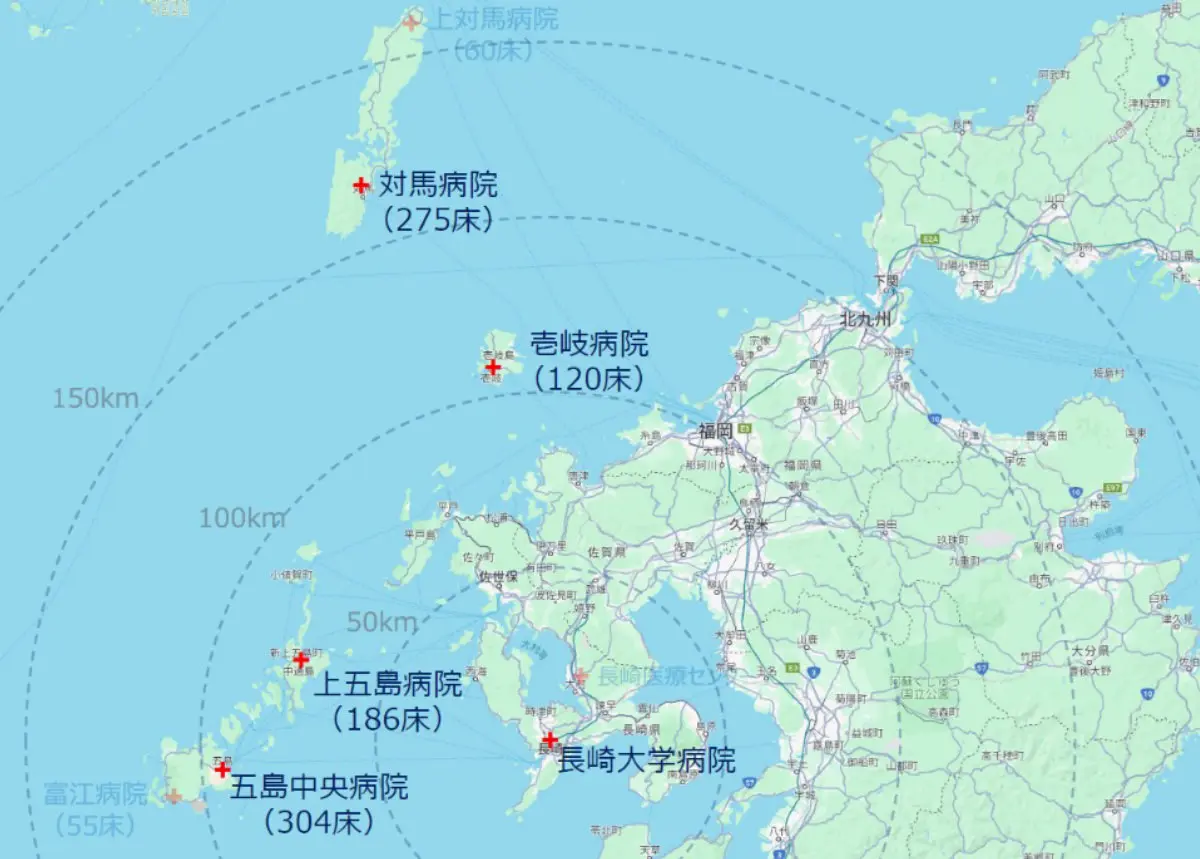
Source: Materials provided by Nagasaki University Hospital
I think this telemedicine support system using local 5G is a pretty good system for making diagnoses and medical policy decisions. Even though there are various local circumstances, I hope it will be used nationwide in the future," said Teiichiro Miyazaki, Assistant Professor of Neurology, who is actually in charge of remote medical support at Nagasaki University Hospital.
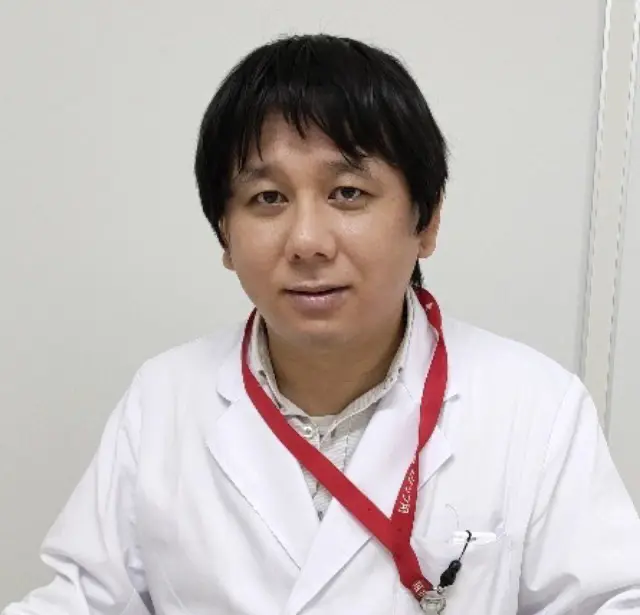
Assistant Professor Teiichiro Miyazaki, Department of Neurology, Nagasaki University Hospital
Nagasaki University Hospital has an important mission to provide medical support for the remote islands, and Assistant Professor Miyazaki also travels to the islands every month to provide medical care.
There are few core hospitals on remote islands, and unfortunately, it is not possible to treat all illnesses there. For example, there are no specialists in neurology, my specialty, on the islands of Nagasaki Prefecture. There are diseases that should be treated by specialists that are difficult to treat on remote islands." (Assistant Professor Miyazaki)
Patients who cannot be treated at hospitals on the islands are referred to hospitals on the mainland, such as Nagasaki University Hospital, but as Takeji points out, it is not easy to get to the mainland from the islands. In addition, the islands have an aging population and a serious shortage of caregivers, and patients who have difficulty walking face a high hurdle in getting to the hospital.
Long-distance hospital visits by boat are affected by the weather and are very difficult. That is why we wanted to make it possible for patients to be seen at hospitals on remote islands rather than on the mainland. But there are no specialists there, so being able to provide telemedicine support to remote islands would be very beneficial." (Assistant Professor Miyazaki)
Local 5G will dramatically improve the effectiveness of remote medical support systems
Against the backdrop of recognition of these issues, Nagasaki Prefecture and Nagasaki University Hospital launched a demonstration of remote medical care support with Goto Central Hospital in FY2020, forming a consortium with NTT Field Techno and others, and commissioned by the Ministry of Internal Affairs and Communications under the "Development and Verification for the Realization of Local 5G, etc. to Solve Regional Issues" to build a remote medical care support system using local 5G. The remote medical examination support system utilizing local 5G was constructed.
Local 5G Remote Specialty Care Support System Configuration
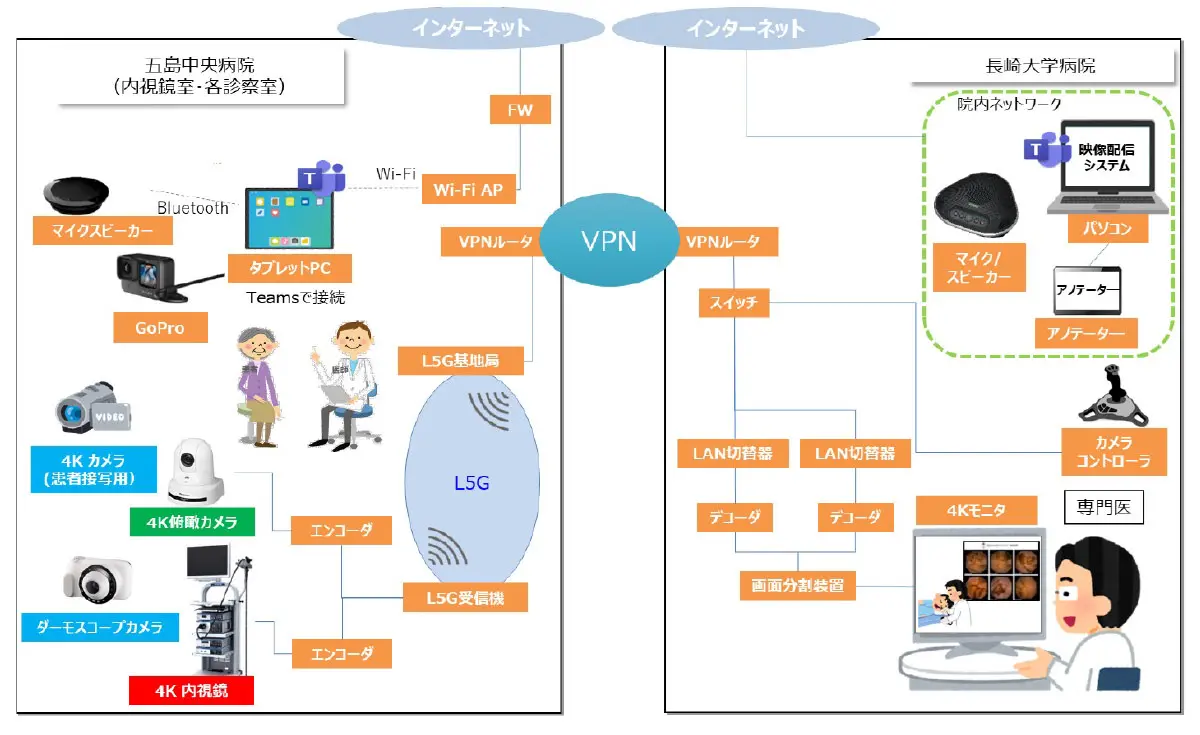
Source: Materials provided by Nagasaki University Hospital
Equipment in an examination room at Nagasaki University Hospital (Photo courtesy of Nagasaki University Hospital)
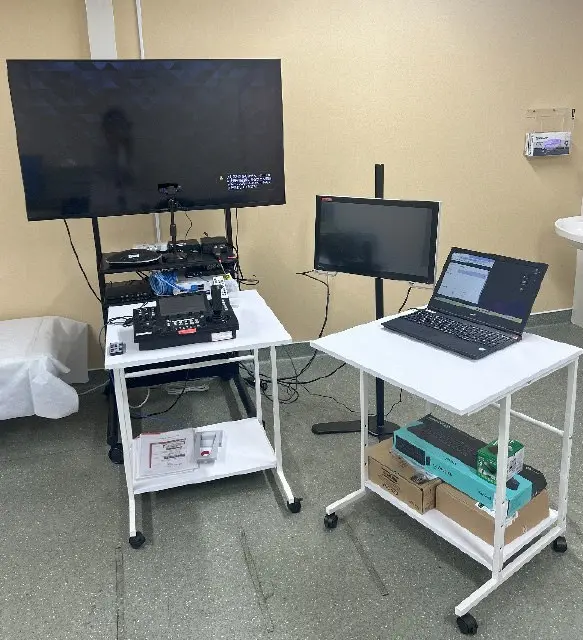
The system is designed to connect a 4K camera and 4K endoscope installed in an examination room to a local 5G system at a hospital on the remote island side, from where video and audio can be transmitted in real time to the Nagasaki University Hospital. In addition to audio transmission from the Nagasaki University Hospital side, a 4K camera installed in a hospital on a remote island can be remotely operated from the Nagasaki University Hospital. Using the example of a neurologist, the system allows the university hospital to give voice instructions to a patient at a remote island hospital, while checking how the patient is moving in real time via 4K high-definition video.
Telemedicine support in neurology (Photo courtesy of Nagasaki University Hospital)

Currently, the system has been installed at the three core hospitals in the Kami-Goto, Tsushima, and Iki medical regions, and connected to Nagasaki University Hospital, where it is being used for actual medical care in three departments: neurology, dermatology, and gastroenterology. According to Taketsugu, these three departments were chosen because doctors cannot touch patients in remote medical care, so it is effective to see them with their own eyes.
In fact, Nagasaki University Hospital had been working on remote medical care support for remote islands using smart glasses since the year before this development demonstration began. At that time, the verification experiment was conducted using a method in which video and audio from smart glasses worn by doctors on the remote islands were transmitted to Nagasaki University Hospital via carrier 4G lines, but the introduction of local 5G has greatly improved the usefulness of the remote medical care support system, according to Assistant Professor Miyazaki.
As a neurologist, one of the good things about the local 5G is that the video sent to us is clearer and the line is faster. Neurology patients have symptoms such as inability to perform fine movements and slow movements, but with the 4G connection, communication was not stable and it was sometimes difficult to evaluate the speed of fine movements and movements from the video sent to us. Local 5G is stable and fast and rarely causes problems. I can say that 4K video in a local 5G environment is of a quality that does not interfere with medical treatment." (Assistant Professor Miyazaki)
In the telemedicine support of neurology, communication delays and unstable video quality (e.g., images stopping in the middle of the video, frame-by-frame transmission, etc.) are major problems, but the introduction of local 5G has virtually eliminated such problems.
At Nagasaki University Hospital, in addition to neurology, gastroenterology and dermatology departments are also using this system to provide remote medical support. The gastroenterology department provides remote medical support by transmitting 4K endoscope images from a remote island, and the physicians in charge of the department say that they have no problems viewing endoscope images with this system. The clarity of images and video is extremely important for any medical department, and the ability to transmit 4K images with stable quality is of great significance.
Telemedicine support in gastroenterology (left) and dermatology (right) (Photo courtesy of Nagasaki University Hospital)
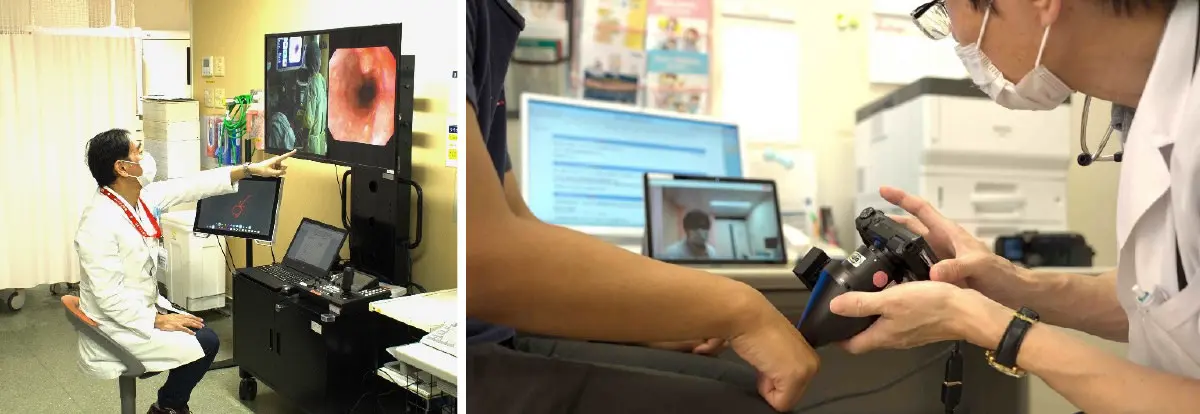
With this system, which uses local 5G, it means a lot to be able to see patients in 4K video. The doctors on the other end of the line are not specialists, so there were times when we could not get the information we thought we needed through consultations using documents or telephone calls. There are still things that can be learned by examining the patient on video. There are many things that cannot be conveyed in words, such as the overall mood of the patient, but can be easily understood if a specialist examines the images, so this system has great merit. (Assistant Professor Miyazaki)
Telemedicine Support Secures Medical Opportunities on Remote Islands
Local 5G's communication speed, low latency, and stable communication quality are highly regarded by medical specialists, and the realization of such remote medical support has led to securing medical opportunities on remote islands and more effective remote island medical support.
I go to the hospital in Gotō once a month, and to begin with, there are so many patients that the local doctors say, 'I don't know what's going on, so I want you to see me. It is difficult to examine all of them there, so if I need to touch the patient directly, I go there and examine them, but if not, I use this remote system to examine them. By doing so in advance, we can properly focus on the patients we will see directly when we go to Gotō." (Assistant Professor Miyazaki)
In addition, it has become much easier to collaborate with hospitals on remote islands, not only when examining patients, but also when performing tests.
We are now able to exchange a variety of information in advance, such as MRI scans taken at remote island hospitals and other images that can be viewed here, and we can provide our knowledge as medical specialists to hospitals in other countries. When a doctor is unsure about a patient, he or she can more easily consult with us. There have been cases in which patients with urgent needs were consulted through this system, and when additional tests were needed, the patient was transferred to our hospital on short notice. (Assistant Professor Miyazaki)
Assistant Professor Miyazaki hopes that this system will cover the situation where it is practically difficult to assign enough specialist physicians to hospitals on remote islands.
D to D with P Advantages and Challenges of Telemedicine Support
The remote medical care support system, however, is a "D to D with P" system that connects two hospitals to provide medical care support, with doctors on both sides. This system has been highly evaluated by doctors in the field for its usefulness in actual medical care, but the D to D with P system has both advantages and challenges.
According to Assistant Professor Miyazaki, the biggest advantage is that patients do not have to touch the equipment themselves.
The general telemedicine system is a one-on-one connection between the patient and the doctor, so the patient needs to set up and operate the environment for use. This is difficult for young people, but not for patients with neurological intractable diseases or elderly patients. With this system, the settings are set up and arranged by the hospital's medical staff, which eliminates such problems and prevents setting mistakes and communication errors. I think this is very good."
On the other hand, the challenge is the manpower required. Simple calculations indicate that the manpower cost is twice as high. However, under the current system, only a single reimbursement is paid, except in the case of certain diseases such as intractable diseases.
Therefore, if this telemedicine support system is to be extended to general practitioners, I think it will be a problem from a managerial standpoint. Doctors are not motivated only by money, but it is unreasonable to force general practitioners to make a loss. In the future, I think it would be good if we could also work with family doctors remotely, but we need to think about how to deal with the system in order to spread it widely." (Assistant Professor Miyazaki)
Because there are physicians on both sides, it is more difficult to coordinate the schedules of both physicians than in a regular practice. This is also a challenge for hospitals on remote islands.
The hospital in Gotō has clerks to help with scheduling, but it seems that other hospitals have not yet established a system to that extent. I am sure that as the system is gradually established at each hospital, the use of the system will expand. (Taketsugu)
Wishing to Expand Telemedicine Support - Toward Improving the Medical Environment on Remote Islands
The telemedicine support system is steadily producing results, but what are the possible future developments?
The first thing Nagasaki Prefecture is working on is to promote the use of the introduced system. Here, in addition to the system development at each hospital as pointed out by Mr. Taketsugu, it is important to build a relationship that allows hospitals to work together smoothly. Nagasaki Prefecture is working to strengthen the relationship between hospitals by, for example, holding council meetings attended by the heads of clinics on remote islands.
Mr. Taketsugu would like to work on expanding the number of medical departments covered and the number of medical institutions.
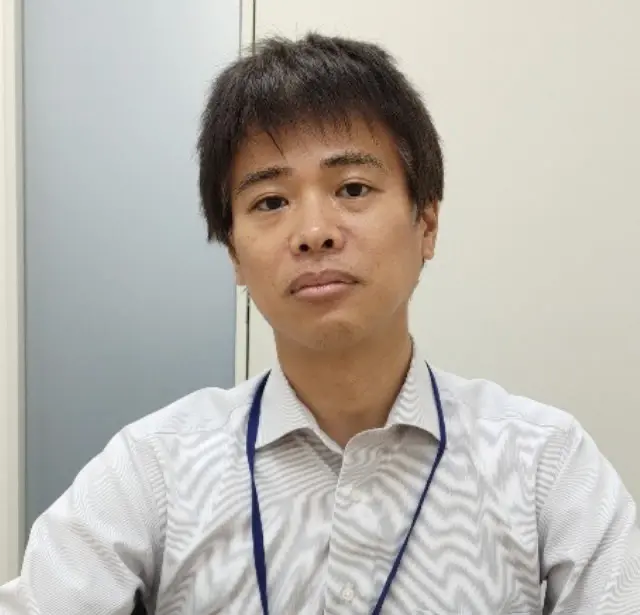
Jun Taketsugu, Medical Human Resources Office, Department of Welfare and Public Health, Nagasaki Prefecture
I think it would be good if we could provide remote medical care not only at core hospitals, but also at medical institutions close to the island. Since there are no resident doctors in remote areas, I think we need to consider a form of remote communication by nurses. This initiative is for specialized care, but it will also be important to be able to provide telemedicine for more general care in a manner similar to that of a family doctor."
Assistant Professor Miyazaki believes that if the cost and institutional issues are resolved, it may be possible to introduce the system to clinics on small remote islands.
If we consider smaller, more remote islands, this system could be used in local clinics without any problems. It is not necessary to have a doctor there, and the system can be handled by a nurse. The system can be used to train the nurses in advance so that they can assist the local nurses with the movements necessary for the clinic."
There is still much more to be done to challenge this system to improve the medical environment on remote islands.
In an interview, Mr. Takeji told us the following
We were also new to local 5G, so we were concerned about how well it would work. When we actually introduced the system, we found that it can be used to this extent, and medical professionals have also evaluated it as convenient. We have also received compliments from the doctors at Nagasaki University Hospital, which is a relief for us."
Nagasaki Prefecture has also received inquiries from other prefectures.
The use of local 5G has enabled telemedicine support that even specialists appreciate. This achievement is a breakthrough that will lead to a wider range of telemedicine. The next developments, including institutional measures, are awaited.
*This article was prepared as part of a project contracted by the Ministry of Internal Affairs and Communications.